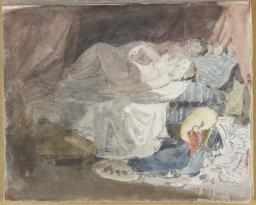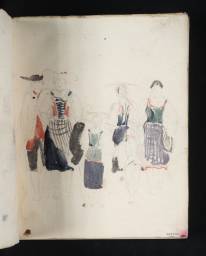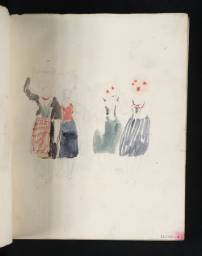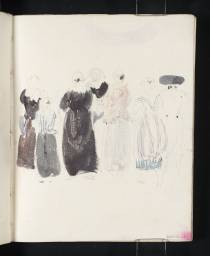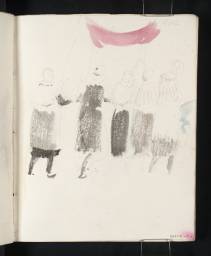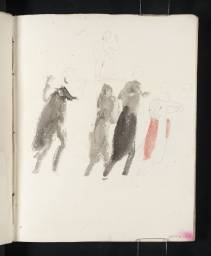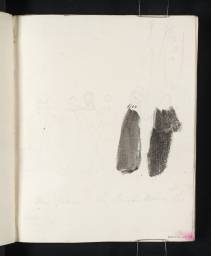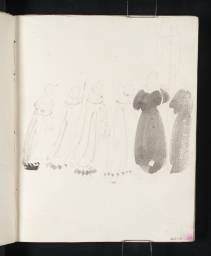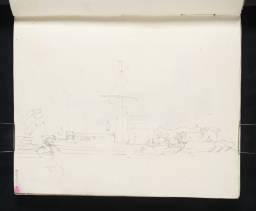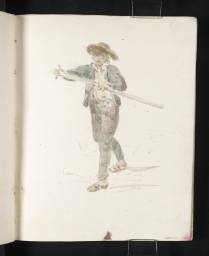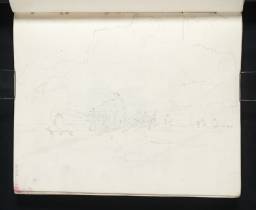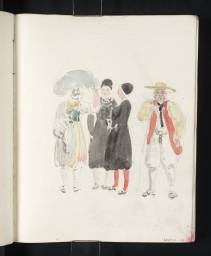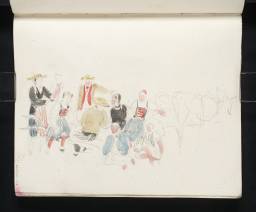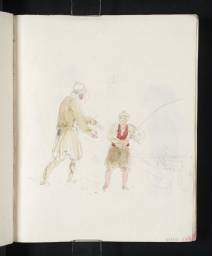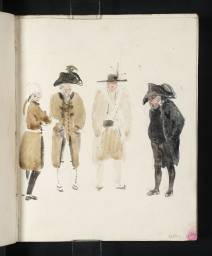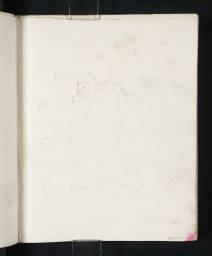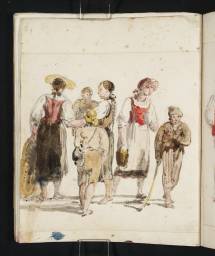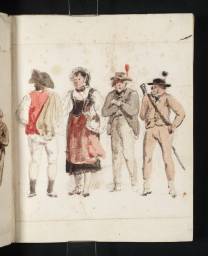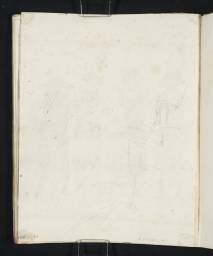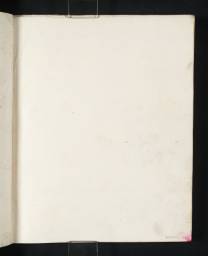Turner Bequest LXXVIII
Quarto sketchbook bound in vellum, stiffened with glue, with a 4-ply laminated paper wallet inside the back cover
74 leaves of white laid paper
Approximate page size 198 x 163 mm
Paper made by Samuel Emanuel Gruner at his mill, Zu Thal, Berne. Various leaves watermarked with faint ornamental monogram and countermarked ‘SE GRUNER’
Inscribed by an early hand in ink on the spine ‘14’, and perhaps by Turner in ink on a label attached beneath it ‘69’
Numbered 239 as part of the Turner Schedule, and endorsed by the Executors of the Turner Bequest, Henry Scott Trimmer and Charles Turner, in ink ‘Containing 20 leaves.| Pencil and Color’d sketches’ and in pencil by Charles Lock Eastlake ‘C.L.E.’ on back cover, inverted. John Ruskin’s further endorsement was recorded by Finberg: ‘239.Valueless. Two or three grotesque figures left in it. Three leaves cut out of Swiss figures. Of which two at M[arlborough] H[ouse]’
74 leaves of white laid paper
Approximate page size 198 x 163 mm
Paper made by Samuel Emanuel Gruner at his mill, Zu Thal, Berne. Various leaves watermarked with faint ornamental monogram and countermarked ‘SE GRUNER’
Inscribed by an early hand in ink on the spine ‘14’, and perhaps by Turner in ink on a label attached beneath it ‘69’
Numbered 239 as part of the Turner Schedule, and endorsed by the Executors of the Turner Bequest, Henry Scott Trimmer and Charles Turner, in ink ‘Containing 20 leaves.| Pencil and Color’d sketches’ and in pencil by Charles Lock Eastlake ‘C.L.E.’ on back cover, inverted. John Ruskin’s further endorsement was recorded by Finberg: ‘239.Valueless. Two or three grotesque figures left in it. Three leaves cut out of Swiss figures. Of which two at M[arlborough] H[ouse]’
Exhibition history
References
This sketchbook was used during Turner’s first continental tour in 1802 (see Introduction, Sketchbooks from the Tour to Switzerland 1802). He bought it in Berne, where he arrived around the end of August, and used it for studies of figures and costume.
Turner had already made similar studies while travelling in Scotland the previous year, in his Scotch Figures sketchbook (Tate D03440–D03631; Turner Bequest LIX). If his intention now was to assemble a repertoire of local characters to incorporate in pictures of Swiss subjects, his sketches are sometimes slight, and even when coloured, provide only limited information about their dress. Most were probably made in Berne itself, but others of a more rustic character must have been made elsewhere. A sketch of boats on a lake on folio 11 (D04808) has been variously associated with Turner’s subsequent visits to Thun and Lucerne, while he also took out the sketchbook to make a single sketch of the Rhine at Schaffhausen on folio 18 verso (D04817). If he looked this up when planning his picture Fall of the Rhine at Schaffhausen (Museum of Fine Arts, Boston)1 for exhibition in 1806, he may also have referred to the adjacent costume studies for the array of carefully-attired figures in its foreground – which indeed the critic of the Star (8 May 1806) thought had been ‘dressed from a book of Swiss costume’.2 The white blouse and skirt and red bodice of a girl who appears in two watercolours of Bonneville3 may also have been sourced from the sketchbook; see folio 17 verso [formerly recto] (D04814). Several sketches record a religious procession, evidently on a saint’s day, of the kind he had already witnessed at Martigny (Tate D04580; Turner Bequest LXXIV 87). These contrast with the ribald character of the most finished drawing in the book, of a couple embracing in a rumpled bed, on folio 1 (D04798), and with the verses of the old ballad ‘I am a Friar of order’s grey’ inscribed inside the back cover (D04797), each suggesting a fresh appreciation – actual or imagined – of the worldly pleasures of the city and of travel. Turner’s travelling companion, Newbey Lowson, celebrated his twenty-ninth birthday at the beginning of September and the festivities could have included a visit to one of Berne’s brothels.
Folios 19–73 (D04818–D04872) were not drawn on by Turner and remain completely blank. As usual, Turner’s executors counted only drawn leaves, amounting in this case to twenty. The erotic subject perhaps holds the key to the disparity between their total and the nineteen surviving today. As his own endorsement confirms, at some point in 1857 Ruskin removed three leaves, only two of which, folios 17 and 18 (D04814, D04816) – now restored to the book – he put on public display at Marlborough House. Finberg speculated that the third, whose subject was not recorded, was folio 19 (D04818), but this would not make up the original twenty. He thought that the last page had been cut out, and a residual strip of paper trimmed almost to the gutter might be evidence of this. However, there is another similar at the beginning, bearing traces of watercolour, suggesting there may have been another leaf immediately in front of the erotic subject. Could this have been another similar, but of a more explicit kind? It is in fact surprising that Ruskin spared even the surviving drawing, and would be the more so if he took the trouble to remove its immediate predecessor – even if, as Ian Warrell has shown, his editing of such material was not complete or consistent.4 A further, separate possibility is that the twentieth leaf was that inscribed with verses (D04797), which is now at the end of the book, stuck to the upper side of the paper wallet. Whether originally there or elsewhere in the book, it may have been counted in the executors’ tally but was not numbered by Finberg, who noted it at the beginning of his list of contents.
Martin Butlin and Evelyn Joll, The Paintings of J.M.W. Turner, revised ed., New Haven and London 1984, pp.48–9 no.61 (pl.72).
Andrew Wilton, The Life and Work of J.M.W. Turner, Fribourg 1979, p.345 no.400 and p.343, no.381; Sotheby’s sale, London, 4 July 2007, lots 8 and 13.
Technical notes
How to cite
David Blayney Brown, ‘Swiss Figures sketchbook 1802’, sketchbook, October 2009, in David Blayney Brown (ed.), J.M.W. Turner: Sketchbooks, Drawings and Watercolours, Tate Research Publication, December 2012, https://www

